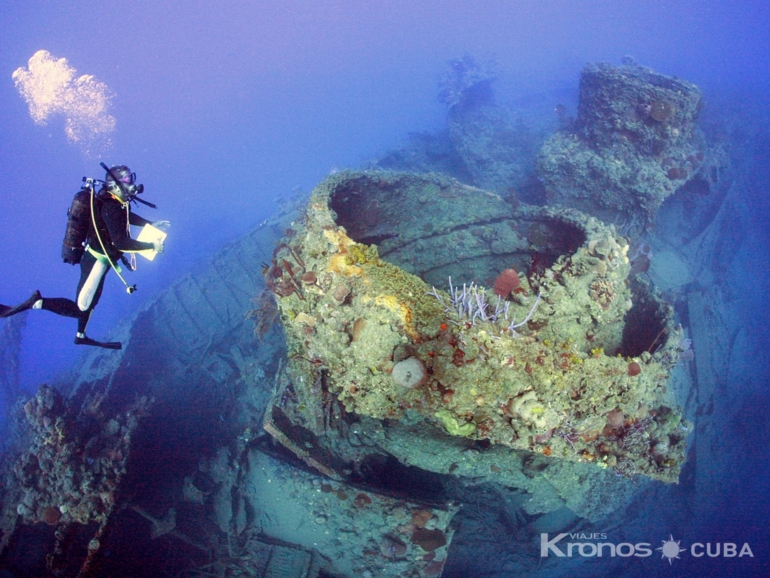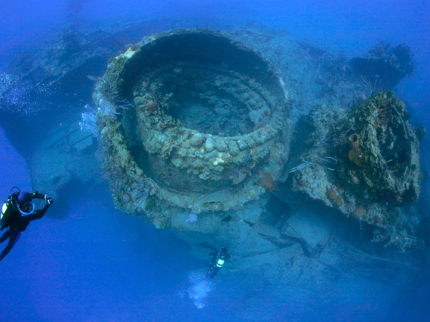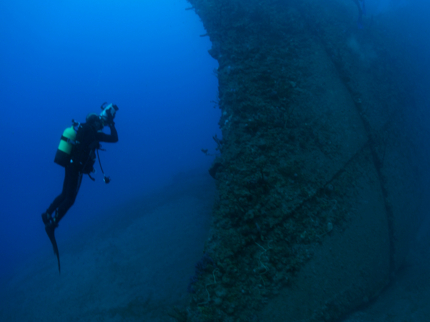General Information and Program Details
- Duration: 4 hrs
- Departure time: 09.00 hrs
- Tour guide: Yes
- Children are allowed: No
- Languages spoken: Spanish and English
- Location: Campismo Río La Mula, Guamá, Santiago de Cuba.
- The boat is shared.
- A minimum of 5 divers is required for the excursion. Viajeskronos will reconfirm 48 hours before the departure of your tour. If the provider decides to cancel, for not meeting the minimum required amount of passengers, Viajeskronos will offer an alternative tour or fully refund cost of your trip.
- Transportation not included in the services of the diving excursions in Santiago de Cuba. The client must arrive at the Marina Marlín in Punta Gorda by his own means 30 minutes before the indicated time of the excursion.
- The excursion can be cancelled in an unexpected way if the general weather conditions and especially in the sea advise it. This does not imply any responsibility or penalty for the agency and the marina company offering the service. In principle we will try to change the date of the excursion for the following days when the conditions improve. If this is not possible, we will proceed to refund the total value of the excursion paid by the client previously.
- The client must present a valid diving certificate issued by an internationally recognized diving organization.
- The client must sign a waiver of responsibility for diving as a risky activity, releasing the agency and the marine company offering the service from any legal responsibility, before leaving for the excursion.
Scuba Diving in Wrecks of the Hispanic - Cuban and North American War of 1898. "CRISTOBAL COLÓN BATTLESHIP CRUISE"
General Description:
Archaeological Park of the Natural and Cultural Underwater Heritage, Naval Battle of Santiago de Cuba Declared a National Monument in 2015.
One of the groups of the Underwater Cultural and Natural Heritage of greatest historical significance in the country is the Archaeological Park of the Underwater Natural and Cultural Heritage Battle of Santiago de Cuba, declared a National Monument in 2015. It is a true privilege to enjoy today the immersions in these wrecks of the 19th century in front of the Sierra Maestra mountain range, in warm, transparent waters, in an environment of spectacular beauty and with a name as suggestive as the Caribbean Sea.
The place is made up of seven archaeological sites (Playa Siboney, Las Cuatro Bocas, Playa Mar Verde, Rancho Cruz - Buey Cabón, Ensenada de Juan González, Aserradero and Playa La Mula), where the wrecks of five Spanish and two North American ships linked to the conflict lie, and objects belonging to the ships, including masts, ironwork, part of the artillery and projectiles.
It covers a territorial extension of some 64,824 nautical miles, equivalent to some 120,051 km along the coast from Siboney beach, belonging to the municipality of Santiago de Cuba, to "La Mula" beach, referring to the municipality of Guamá.
The area of the coastal strip of the province of Santiago de Cuba was the scene of one of the most transcendental naval events in the history of mankind. This naval battle, which culminated in the sinking of the fleet of Vice Admiral Pascual Cervera y Topete, put an end to Spanish colonial rule in America.
These sites are must-see for researchers, archaeologists, divers and tourists in general, not only because of their great historical value, but also because of the spectacularly beautiful surroundings where they have been found for more than a century of rest and biological activity, creating special ecosystems where the sessile fauna and marine flora have merged with the wrecks.
It is a privilege to know the universal history through these wrecks, witnesses of the events of this Naval War, undoubtedly a treasure of the Underwater Cultural Heritage, which is part not only of the History of Cuba, but of the Universal one.
ARCHAEOLOGICAL SITE: "PLAYA LA MULA". Wreck: "Cristóbal Colón" battleship cruise ship
- Municipality: Guamá.
- Site: La Mula Beach. West of the mouth of the Turquino River, municipality of Guamá, 50.4 miles from Santiago de Cuba.
- The Crucero Acorazado "Cristóbal Colón" is located in the surroundings of the La Mula settlement, west of the mouth of the Turquino River and 50.4 nautical miles from Santiago de Cuba, about 80 meters from the coast and between 12 and 37 meters deep.
Historical Background
- In 1895, Spain in its efforts to strengthen the navy, bought an armored cruise ship, the "Cristóbal Colón", which would build the house Gio Ansaldo & Cia. in the shipyard Ansaldo Sestri Ponenti in Genoa, for the Italian Regia Mariana its construction was supervised by the Minister of Navy for Restoration, Admiral Berenguer. Spain paid 690,000 pounds sterling, the duration of the construction work was 6 months
- The armoured cruiser "Cristóbal Colón" was launched after several attempts on 16 September 1896 at 9 a.m. in the port of Genoa. The ship was delivered to the Spanish government on May 19, 1897, the same day of the following year it would arrive at the coast of Santiago de Cuba, its final destination.
- This ship was a novelty for its time, it had 24 Niclause boilers, 13,000 horsepower, capable of moving a steel mass of 6840 tons of displacement and achieve the impressive speed, for the time, of 21 knots.
-Commander Emilio Díaz Moreu was at the head of this battleship. On the day of the battle, it left through the channel in the bay of Santiago de Cuba and faced a combat on the high seas, with numerical inequality and without its battery of heavy caliber cannons, which would mean the sinking of the ship on July 3, 1898, at 13:25 hours and the total loss of its 543 crew members.
- The armored cruise ship "Cristóbal Colón" is one of the best preserved in the world, taking into account the proximity to the coast and its more than 110 years submerged in open sea and tropical waters. Some objects from the ship, which are in our country, are exhibited in the museums of the Spanish-Cuban-American War, the Morro Castle and the Marine Museum in the Baconao Park aquarium. Other pieces are part of some private collections or are exhibited in museums abroad (United States and Spain).
TECHNICAL CHARACTERISTICS OF THE CHRISTOPHERIC SHIP "Cristóbal Colón"
- Name of the wreck: “Cristóbal Colón”.
- Class: "Giuseppe Garibaldi".
- Shipyard: "Sestri Ponente" of Ansaldo, Genoa, Italy.
- Flag: Spain.
- Type of ship: 1st class battleship cruise.
- Date of entry into service: 16 September 1896.
- Launch date: July 24th, 1889.
- Commander: Captain Emilio Diaz Moreu.
- Crew members: 543 men.
- Beam: 18.20 meters.
- Strut: 12.19 meters.
- Draft: 7.75 meters.
- Displacement: 6,840 tons.
- Maximum speed: 20 knots.
- Length: 100 meters.
- Autonomy at low consumption: 8,300 miles (nautical).
- Type of bow: Inverted launch.
- Rudder: Aft, spade outside the transom with shaft running to deck, driven by a servo motor.
- Decks: Steel and wood.
- Shielding: Stainless steel 120 to 150 mm, two thirds of the length.
- Deck armor: Deck 25 to 30 mm.
- Barbets: 150 mm.
- Type of feeding: Mineral coal.
- Type of machinery: 2 vertical triple expansion machines.
- Power : 13 000 CV.
- Boilers : 14 "Niclause" boilers.
- Propulsion : 2 propellers.
- Masts : 1 mast.
- Large caliber artillery: 2 bases of the 254 mm "Amnstrong" cannons turrets, 152 mm cannons: 10 pieces.
- Rapid fire artillery: 120 mm cannons (rapid fire): 6 pieces. 10 Nordenfelt 57 mm cannons (rapid fire).
- Medium caliber artillery: 10 Hotchkis Revolvers 37 mm.
- Maxims" machine guns: 2 pieces.
- Torpedo tubes: 5 torpedo launchers 365 mm.
Details of the excursion
- Diving services included: Basic diving equipment, compressed air tank, weight belt.
- You will have an internationally certified instructor-guide who will give you an informative briefing on the dive to be done.
- Boat that will take you from the diving center to the diving points (In principle, the dives leaving from the nautical base of Campismo Rio La Mula will be done by diving boat when the excursion exceeds the number of 10 divers).
Distance to be covered in the excursion (round trip): 40 kms approximately.
Degree of difficulty: Medium.
Approximate duration of the excursion: 4 hours approximately
VERY IMPORTANT NOTES:
- It is obligatory for the clients to present their official certified diving qualification.
- Never, for safety and protection of underwater heritage, customers may directly touch the remains of sunken ships and must strictly comply with the instructions issued by the diving instructors.
- Although in the 27 meters (bow of the wreck) it is possible to dive within the safety curve for up to 25 minutes, when you have large tanks it is important to be aware of the time, decompression stops and the orientation of the instructor or guide (in the case of tourists and amateurs); since it is relatively frequent that some amateurs, absorbed by the impressive panorama, forget the essential safety rules.
- With the sea slightly moved it becomes dangerous the entrance and exit from the beach, by the frequency and intensity of the waves that break the stone slope, the possibility of falls and breakage of the equipment; in addition to possible blows and physical damages to assistant and foreign divers. It is important to point out that with the sea moving it is practically impossible to access from land.
TIPS: • Recommended: light clothing, swimsuit, towels, sunglasses, hat, sunscreen and photographic camera. • We recommend that the client can bring their own diving mask. • The client can bring his complete diving equipment if he wants to. • We recommend that the client can bring his/her personal dive computer. • We recommend that the client can bring one or more bottles of mineral water to stay hydrated as well as light foods rich in protein or fruit.
BOOK SCUBA DIVING IN WRECKS OF THE HISPANIC - CUBAN AND NORTH AMERICAN WAR OF 1898. "CRISTOBAL COLÓN BATTLESHIP CRUISE".
-
Collective diving tour (2 dives)Diving tour with professional diving instructor service in several languages and (2 dives). Transportation service by the client. (Clients must have transportation to include the instructor and the equipment).1 Adult(Daily departures)Not departure in selected date








